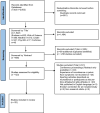Elite female athletes' experiences of symptoms of pelvic floor dysfunction: A systematic review
- PMID: 36040507
- PMCID: PMC9477953
- DOI: 10.1007/s00192-022-05302-6
Elite female athletes' experiences of symptoms of pelvic floor dysfunction: A systematic review
Abstract
Introduction and aims: Pelvic floor dysfunction (PFD) is a collection of signs, symptoms and conditions affecting the pelvic floor and urinary incontinence (UI) is the most common type of PFD. Recent systematic reviews have indicated a higher prevalence of UI among female athletes compared to their non-athletic counterparts. To date, no review has been undertaken to investigate female athletes' experiences of PFD. This review aims to offer insight and understanding, through aggregation, summary, synthesis and interpretation of findings from studies that report elite female athletes' experiences of symptoms of PFD.
Methods: The review protocol was registered in PROSPERO in August 2020. A systematic search was conducted in Embase, MEDLINE (OVID), Cochrane Library, CINAHL, PsycINFO and Web of Science for studies published in the English language reporting elite female athletes' experiences of symptoms of PFD. This review included primary research studies that involved elite female athletes of any age or ethnicity.
Results: Of the 1922 citations retrieved in the search, 32 studies met the methodological criteria for data extraction and analysis. Five main themes emerged: (1) triggers for symptoms of PFD; (2) strategies adopted by athletes to manage/mitigate symptoms of PFD; (3) impact on QOL/daily life; (4) impact on performance; (5) impact on emotions.
Conclusions: The findings of this review suggest a need to further explore the experiences of PFD among elite female athletes and it is suggested that future research should adopt qualitative methods or incorporate a qualitative component.
Keywords: Elite athletes/sportswomen; Experiences; Pelvic floor dysfunction.
© 2022. The Author(s).
Conflict of interest statement
None
Figures
References
-
- Haylen BT, de Ridder D, Freeman RM, Swift SE, Berghmans B, Lee J, et al. An International Urogynecological Association (IUGA)/International Continence Society (ICS) joint report on the terminology for female pelvic floor dysfunction. Int Urogynecol J. 2010;21(1):5–26. doi: 10.1007/s00192-009-0976-9. - DOI - PubMed
-
- Bo K, Frawley HC, Haylen BT, Abramov Y, Almeida FG, Berghmans B, et al. An International Urogynecological Association (IUGA)/International Continence Society (ICS) joint report on the terminology for the conservative and nonpharmacological management of female pelvic floor dysfunction. Neurourol Urodyn. 2017;36(2):221–244. doi: 10.1002/nau.23107. - DOI - PubMed
Publication types
MeSH terms
LinkOut - more resources
Full Text Sources
Medical
Miscellaneous


